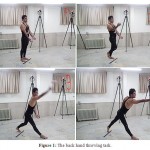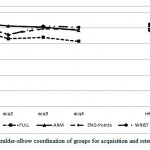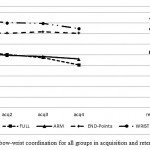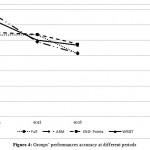How to Cite | Publication History | PlumX Article Matrix
The Effect of Observing Different Types of Information on Learning a Novel Motor Skill
Hossein Hajatmand Ghalehroudkhani, Mehdi Sohrabi and Hamidreza Taheri Torbati
Faculty of Sport Sciences, Ferdowsi University of Mashhad, Iran.
Corresponding Author E-mail: http://hajatmand@um.ac.ir
DOI : http://dx.doi.org/10.13005/bbra/2330
ABSTRACT: Relative information is the most important constraint during observation. The present study examined the importance of observing different types of information during observational learning. Participants observed one of the following types of information: whole body (FULL), arm of the throwing hand (ARM), wrist of the throwing hand (WRIST), or the end points of the upper and lower limbs (END- POINTS). During 30 acquisition trials (3 blocks), the participants observed a model five times before the first trial and once before each remaining trial of each block. The retention test (10 trials) was performed the following day. Shoulder-elbow and elbow-wrist intra-limb coordination was assessed in comparison withthe model. During acquisition, FULL and ARM groups were more accurate in reproducing the model’s action than the other two groups. These results were repeated during retention tests, which provide partial evidence to the visual perception perspective notion. It was concluded that the end effector is an important source of information, and observing this type of information is enough for learning a novel motor skill.
KEYWORDS: observational learning; relative information; intra-limb coordination; visual perception perspective; novel skill
Download this article as:| Copy the following to cite this article: Ghalehroudkhani H. H, Sohrabi M, Torbati H. T. The Effect of Observing Different Types of Information on Learning a Novel Motor Skill. Biotech Res Asia 2016;13(3). |
| Copy the following to cite this URL: Ghalehroudkhani H. H, Sohrabi M, Torbati H. T. The Effect of Observing Different Types of Information on Learning a Novel Motor Skill. Biotech Res Asia 2016;13(3). Available from: https://www.biotech-asia.org/?p=15927 |
Introduction
Learning is a process that requires practice and experience (1), takingplace through various methods including physical and mental practice and action observation. Action observation, sometimes referred to as observational learning, is a process in which observers try to learn and repeat an action throughobserving a model(2).Research on observational learning has been done in several areas(3).Much of early development has been attributed tothe processes of social learning (4). One of the main interests of researchers is the typeof information used when people observe a model.Bandura(4, 5)didnot discuss this issuein his Social Learning Theory. However, Visual Perception Perspective theory (6)states that an observer perceives and uses the relative information,and this type of information is a prominentconstraint during observational learning. Researchers have tested visual perception perspectiveusing Point Light Displays (PLD) (7-9). They believe that important information is more salient in PLDdemonstration and the identification and perception of movement is easier compared withvideo presentation (10), arguingthat the relative information is better distinguished in PLD compared withvideo presentation; hence, if the relative information is the basis of observational learning, PLD must result in better learning compared to video presentation (7). Accordingly, some studiesshowed that watching dance steps through PLDresults in a better learning than watching via video presentation(11).However, the priority of PLD model over video model hasnotbeen confirmed in otherstudies. In a study conducted on throwing darts,no significantdifference was observed betweenPLD and video model(7). Similarly, Horn et al(8, 9)found no significant difference between these two representation models.However, some researchers claim that those studies havenot directly manipulated relative information, and without a direct manipulation,its role in observational learning could not be taken into account(12-16).UsingPLD techniques, Hodges, et al. (16)manipulated the relative information in a soccer kicking action. The informationdisplayed includedrelative information (markers attached on all over the leg), restricted relative information (two markers attached on the foot), and absolute information (a marker attached on the ankle). The argument was that if relative information plays the main role in observational learning, those who observed absolute information would learn less than other two groups.The results were contradictory,and those who observed absolute information performed more similar tothe model than those in other groups. It wasconcluded that information related to the movement endpoint has a crucial role in observational learning (16, 17). Theresults were repeatedin another study performedon bowling throwing action(15). Nonetheless, in astudy on cricket throwing task(12), different results were reported; relative and absolute information was presented to different participants,showingthat those who had watched absolute information related to the endpoint did not actas those who had watched relative information (12).Breslin et al.(13)used the same taskin which participants were provided with relative information about the whole body, the throwing hand, thewristof both hands, and the wrist of the throwing hand, indicatingthat all groups didmore like the model than the group who observed the wrist of throwing hand. Researchers have concluded that the amount of information playspossibly a more prominent role compared withthe type of information. Their study was carried out on a similar task and similar groups of participants,showing that groups given relative information onthe whole body and the throwing hand performed better than the other groups. It was concluded thatthe end effector information (information about the throwing hand not the endpoint) plays an important role in learning a novel skill via observation (14, 18).
There are fewstudies onthis research area,which are mostly incongruent. Some studies have emphasizedthe importance of relative information (6, 7);some othershighlightedthe importance of absolute information (16), and others show the importance of restricted relative information (14).Thus,the results of studies in this area are not consistent.Tasks used in previous studies arevery simple (7, 16)andprobablyavailable in observer’s motor repertory(15, 19),which somehow explain thecontradictoryresults.Observational learning maybe more effective if learning a new coordination pattern is required(20). Thus, designing a study with a novel task which probably is not in observer’s motor repertory will be illuminating.
Methods
Participants
Thirty-two male participants were selected from Ferdowsi University of Mashhad, Iran, and assigned randomly into four groups: the whole body information(FULL), the right hand information (ARM), the wrist and feet information(END POINTS),and the wrist onlyinformation (WRIST). All participants met the selection requirements ofthe study, which required no previous throwing experience at an organized club, high school, and college level and were right hand dominant. They had normal and corrected-to-normal vision.Informedconsentswere obtainedfrom theparticipants.
Task
The task involved a backhand throwing adapted from baseball throwing task (Figure1).However, baseball throwing is done with opposite arm and leg with forehand throwing, butthe task was performed as a backhand with the same arm and leg (21). The participants had to start the task from the initial position. In the initial position, hands were stretched out in front of the body (Figure 1, part 1).
Instrumentation
To record the participants’ throwingaccuracy, a square was used with dimensions of 5 (height)× 200 (length)× 200 (width) cm. The square was filled with soft sand to facilitate recording the ball’s landing position. In the center of the square, a red circle with a diameter of 10 cm was designed as the target, and the distance between the participants and the target was 5 m.A Simi Motion Analyzer system with six high speed video cameraswas used for measuring movement kinematics.
Data collection
In order to provide the model, an adult was asked to perform 200 throwing per day for 5 consecutive days. On the fifth day,reflexive markers were attached tothe model’s body to capture the PLDin the following order: distal end of the fifth metatarsal bone (toe), ankle, lateral condylar (knee), trochanteric femoral (hip), acromial process (shoulder), lateral epicondylitis (elbow), radial styloid process (wrist), distal end of the first palmar bone (finger), and forehead (head) (13, 15).One of the trials in which the ball exactly landed on the target was recorded as themodel,using a SIMI motion system.Contextual information was removed throughSIMI motion software so that markers placed on the anatomical landmarks wereobservable as point lights in the video. Thepoint light film was divided,with equal duration,into four tracks: full information, all placed markers on the model’s body were observable(FULL); arm information,where four markers placed on the right hand (throwing hand) were visible (ARM); end points information,where markers placed on the right hand wrist and ankles were observable(END- POINTS); wrist only information, where markers placedon the right hand wrist (WRIST) were observable.
 |
Figure 1: The back hand throwing task.
|
In the acquisition phase, the participants had a 5minbreak to getfamiliar with the laboratory conditions. Before the experiment, 17reflective markers were placed on the major joint centers on both sides of the participants’body. The positioning of themarkers were the same as the model. Afterwards,they signed the consent form. Before beginning ofthe acquisition phase,theparticipants watcheda PLD perceptual training video to ensure thatthey fully understood the conceptual nature of PLD stimuli. The training videowas comprised of a number of daily actions such aswalking, jumping, and running displayedboth in regular video and point light format. This was actually done to eliminate the possible negative impacts of PLD on the participants (15).The training videoswere not similar to the desired throwing task (13-15).After familiarization, the participants performed 30 acquisition trials (three blocks of 10 trials with 2 minbreak between the blocks), where a demonstration was shown five times on trial one and then once before each remaining trial. The participants were instructed toequally emphasize replication ofthe model’s action and hitting the target(12-14). After24 hours, the participants performed 10 trials as retention test. No demonstration was shown to the participants during retention.
Data analysis
Kinematics
The start and end points of movement were standardized. The start point was determined as the initiation of right elbow flexion, and the end point was determined as the maximum extension of right elbow. The data were smoothed with a recursive 4th order Butterworth filter applyinga cut-off frequency of 7 Hz. A linear interpolation normalizedthis period to 100 data points (22), enabling comparison ofthe trials and the model.
A modified version of normalized root mean squared error (NORMS)(23) was usedto provide an index of similarity of intra-limb coordination of participant to the model. In this approach, the model’s trace isused as criterion, and the disparity of each trial iscalculated from model’s criterion trace. Afterwards, this score is normalized for a number of trials and excursion (24);this approach is called as normalized root mean squared difference (NORM-D) (9). A smaller NORM-D score representsa close approximation to the model’s movement trace. The important aspect of this throwing action occursin the right side of the body (right arm and leg). Thus, right shoulder-elbow and right elbow-wrist coordination were used to compare the intra-limb coordination between the participants and the model. All kinematic data were analyzed based on values computed from the first three (ACQ 1, t1–3), last three of the first block (ACQ 2, t8–10), last three of second block (ACQ 3, t18–20), and last three of third block (ACQ4, t28-30) trials of acquisition. In retention, data from the first three (RET1, t1-3) and the last three (RET2, t8-10) trials were used for analysis.
Action outcome
Horizontal and vertical distances between the landed ball and the target were recorded tocalculate theradial error. To measure performance during acquisition and retention, the radial error was used.
Results
Shoulder-elbow coordination
For acquisition period, data were analyzed in a 4 Group (FULL, ARM, WRIST, END POINTS) × 4 Block (ACQ1, 2, 3, and 4) mixed designed ANOVA with repeated measureson the last factor. Also, in retention, a 4 Group (FULL, ARM, WRIST, END POINTS) × 2 Block (Ret 1, 2) mixed design ANOVA with repeated measureson the last factor was used.For all analyses, when violations to sphericity were observed, a Greenhouse–Geisser correction was applied.
Figure 2 depictsthe shoulder-elbow coordination of all groups in acquisition and retention periods. Results did not show a significant difference between groups, F<1. However, a significant main effect of blocks was observed during acquisition, F (1.58, 44.23) = 5.80, P=0.01, ƞ2p= 0.17. Post-hoc analysis for the main effect of blocks showed a significant difference between ACQ1 and ACQ2, and ACQ1 and ACQ4. As it can be seen in Figure 2,the groups improved their accuracy in reproduction of model’s movement. Also, a non-significant interaction effect concerning group× block was observed, F<1.
 |
Figure 2: Shoulder-elbow coordination of groups for acquisition and retention periods
|
In retention, a non- significant main effect of Group, F<1, main effect of Block, F (1, 28) = 2.8, p= 0.15, ƞ2p= 0.09, and interaction effect for Group× Block, F (3, 28) = 1.26, p= 0.30, ƞ2p= 0.12 were observed.
Elbow-wrist coordination
In acquisition, the resulting data were analyzed in a 4 Group (FULL, ARM, WRIST, END POINTS) × 4 Block (ACQ1, 2, 3, and 4) with repeated measureson the last factor. For retention period, data were analyzed in a 4 Group (FULL, ARM, WRIST, END POINTS) × 2 Block (Ret 1, 2) mixed ANOVA with repeated measureson the last factor. Figure 3 shows the elbow-wrist coordination of groups.
 |
Figure 3: Elbow-wrist coordination for all groups in acquisition and retention periods
|
During acquisition, a significant main effect of Group, F (3, 28) = 11.16, P= 0.000, ƞ2p= 0.54, and Block, F (2.66, 63.45) = 6.95, P= 0.001, ƞ2p= 0.19 wasobserved, but, the interaction effect of Group× Block was not significant, F<1.
As Figure 3 shows, all groups improved their elbow-wrist coordination in relation to the model’s action. Post-hoc analysis for the main effect of Group revealed a significant difference between FULL and WRIST, P<0.05, and FULL and END POINTS, P<0.05, groups. Also, significant differenceswere observed between ARM and WRIST, P<0.05, and ARM and END POINTS, P<0.05 groups. The differenceswere not significant between FULL and ARM groups, P>0.05, and WRIST and END POINTS groups, P>0.05. Means comparison showed that FULL and ARM groups performed more like the model compared withWRIST and END POINTS groups (FULL= 23.90, ARM= 24.52, WRIST= 39.67, END POINTS= 35.51).
In retention, the results showed that the main effect of Group, F (3, 28) =11.77, P=0.000, ƞ2p= 0.55, and the main effect of Block, F (1, 28) = 56.02, P=0.000, ƞ2p= 0.66,were significant. A non-significant interaction of Group × Block, F<1, was observed. Based on Figure 3, all groups improved their elbow-wrist coordination in Ret 2 compared withRet 1. As the acquisition period, significant differenceswere observedbetween FULL and WRIST groups, P<0.05, and FULL and END POINTS, P<0.05. Also, the differencesbetween ARM and WRIST groups, p<0.05, and ARM and END POINTS groups, P<0.05, were significant. There was not any significant difference between FULL and ARM groups, P>0.05, and WRIST and END POINTS groups, p>0.05. Generally, FULL and ARM groups performed more like the model action than WRIST and END POINTS groups (means, FULL= 25.56, ARM= 25.83, WRIST= 36.61, END POINTS= 41.51).
Action outcome
Figure 4 shows the groups’ performances during acquisition and retention.The acquisition’s data were analyzed using a 4 model(FULL, ARM, END- POINTS, WRIST) ×3block(ACQ 1, 2, 3) mixed design ANOVA with repeated measures on the last factor.
 |
Figure 4: Groups’ performances accuracy at different periods
|
The mixed ANOVA indicated that the main effect of model was not significant, F<1;however, the main effect of blockswas significant η2p=0.24, p=0.0001, F (2. 56) =9.23.Also, the results showed a non-significant interaction effect of model with blocks,F<1. The results of post-hoc test for the main effect of blocks indicated a significant differencebetween the first and second blocks,P<0.05. Also, a significant difference was observed between the first and third blocks,P<0.05 and between the second and third attempt groups,P<0.050. The means comparisons indicated that all groups reduced their error from the first block to the third block(means, block 1= 29.48, block 2= 25.79, block 3= 22.07)(Figure 4). In the retention phase,one-way ANOVA was performed on the radial errors, indicatingthat the main effect of the model was not significant, F<1.
Discussion
The current study aimedto investigate the effect of observing different types of information on learning a novel motor skill. Shoulder-elbow coordination of all groups improved during acquisition, but no significant difference was observed between the groups in the acquisition and retention tests. Regardingelbow-wrist coordination, FULL and ARM groups performed more like the model compared withthe END-POINTS and WRIST groups in the acquisition and retention periods. Thefindings areconsistent with previous results(12, 14). Observing the end effector may besufficient to learn a novel skill, which isconcluded according to the lack of any significant differencebetween FULL and ARM groups where both groupsperformed better than the END-POINTS and WRIST groups in reproducing the elbow-wrist coordination of the model’s action. Although, it had been shown in previous researchesthat observing the end point of action is sufficient to successfully reproduce the action(15, 16), in this study, observing the end point of action was not enough. Even when the observers viewed the end points of lower and upper limbs, they were not as successful as participants observingthe whole body or whole arm of the throwing hand. Complexity of the task seems important. It is possible that for a single limb action like kicking the ball, the end point information is sufficient, but for a whole body novel action like the actiondescribed in this study, this type of information is not sufficient,and more information is required to successfully reproduce the action (14).When more information was providednot related to the effector limb (END-POINTS),no improvementwas observed in limb coordination relative to the full or restricted relative information. Thus, information pertaining to the action end effector limb ispossibly crucial for learning to occur (14). Thefindings partially support the visual perception perspective’s claims (6). According to this view,during observation,the relative information is the most important constraint at the early stage of acquisition (6). Although,it is shown that observing the relative information is superior than observing the absolute information for learning a novel motor action, it was also reportedthat viewing the restricted relative information (end effector information) is as effective as whole body relative information. This is probably due toimplicitly directing the observers’ attentionto important information. It is also possible that participants who observed the whole body information used the information about the end effector to reproduce the action. Previous studies have shownthat observers direct their visual gaze to the end effector information during observation (14).
For movement outcome data,during acquisition, the results revealedthat the participants’ overall performance improved, but not statistically significant. These non-significant group differencesalso remained in retention period. Thefindings were not consistent with the results of some studies such as Breslin et al.(12-14) and Hodges et al.(16). In previous studies, those observinga movement end point had a better performance (15, 16), and in some other studies, those observingthe end effective informationperformed superior thanothers (14). Differentresearch results could be due to the lack of control over the task constraints. In the presentstudy, all participants had to throw the ball toward a specified target. Studies related to observational learning show that in case of the existence of an external target, participants focus primarily on reaching to the target (19, 25, 26). Accordingly, the participants might have focused on reaching to the target;therefore,theyperformed the task in the same way (in accuracy measure) (26-28). However, in some otherstudies, participants had to only imitate the movement, and no external target was provided(15, 16), indicatingthat task constraints can be effectivein observational learning (25, 29).
The present study partially supports the notion of visual perception perspective (6),indicating that observing the whole body relative information and restricted relative information aresuperior compared withobserving the absolute information or information pertaining to the limbs end points in learning a novel motor skill. In this study, a more implicit method was used to manipulate the relative information. It is possible that manipulating information via a more explicit method would be more influentialin learning a motor skill (14, 30),which requiresfurtherinvestigations.
References
- Schmidt R, Lee T. Motor control: a behavioral emphasis. Champaign IL: Human Kinetics; 2011.
- Williams A, Davids K, Williams J. Visual Perception and Action in Sport (London: E&FN Spon). 1999.
- Ashford D, Bennett SJ, Davids K. Observational modeling effects for movement dynamics and movement outcome measures across differing task constraints: a meta-analysis. Journal of motor behavior. 2006;38(3):185-205.
CrossRef - Bandura A. Social foundations of thought and action: A social cognitive theory: Prentice-Hall, Inc; 1986.
- Bandura A, Walters RH. Social learning theory. 1977.
- Scully D, Newell K. Observational-Learning and the Acquisition of Motor-Skills-toward a Visual-Perception Perspective. Journal of Human Movement Studies. 1985;11(4):169-86.
- Al-Abood SA, Davids K, Bennett SJ. Specificity of task constraints and effects of visual demonstrations and verbal instructions in directing learners’ search during skill acquisition. Journal of Motor Behavior. 2001;33(3):295-305.
CrossRef - Horn RR, Williams AM, Scott MA. Learning from demonstrations: the role of visual search during observational learning from video and point-light models. Journal of Sports Sciences. 2002;20(3):253-69.
CrossRef - Horn RR, Williams AM, Scott MA, Hodges NJ. Visual search and coordination changes in response to video and point-light demonstrations without KR. Journal of Motor Behavior. 2005;37(4):265.
- Johansson G. Visual perception of biological motion and a model for its analysis. Perception & psychophysics. 1973;14(2):201-11.
CrossRef - Scully D, Carnegie E. Observational learning in motor skill acquisition: A look at demonstrations. The Irish Journal of Psychology. 1998;19(4):472-85.
CrossRef - Breslin G, Hodges NJ, Williams AM, Curran W, Kremer J. Modelling relative motion to facilitate intra-limb coordination. Human Movement Science. 2005;24(3):446-63.
CrossRef - Breslin G, Hodges NJ, Williams AM, Kremer J, Curran W. A comparison of intra-and inter-limb relative motion information in modelling a novel motor skill. Human movement science. 2006;25(6):753-66.
CrossRef - Breslin G, Hodges NJ, Williams MA. Effect of information load and time on observational learning. Research quarterly for exercise and sport. 2009;80(3):480-90.
CrossRef - Hayes SJ, Hodges NJ, Huys R, Williams AM. End-point focus manipulations to determine what information is used during observational learning. Acta psychologica. 2007;126(2):120-37.
CrossRef - Hodges NJ, Hayes SJ, Breslin G, Williams AM. An evaluation of the minimal constraining information during observation for movement reproduction. Acta Psychologica. 2005;119(3):264-82.
CrossRef - Hodges NJ, Williams AM, Hayes SJ, Breslin G. What is modelled during observational learning? Journal of Sports Sciences. 2007;25(5):531-45.
CrossRef - Ste-Marie DM, Law B, Rymal AM, Jenny O, Hall C, McCullagh P. Observation interventions for motor skill learning and performance: an applied model for the use of observation. International Review of Sport and Exercise Psychology. 2012;5(2):145-76.
CrossRef - Hayes SJ, Ashford D, Bennett SJ. Goal-directed imitation: The means to an end. Acta Psychologica. 2008;127(2):407-15.
CrossRef - Magill RA. Motor learning and control. Concepts and applications. 2004;7.
- Hayes SJ, Hodges NJ, Scott MA, Horn RR, Williams AM. Scaling a motor skill through observation and practice. Journal of motor behavior. 2006;38(5):357-66.
CrossRef - Winter DA. Biomechanics and motor control of human movement: John Wiley & Sons; 2009.
CrossRef - Sidaway B, Heise G, SchoenfelderZohdi B. Quantifying the variability of angle-angle plots. Journal of Human Movement Studies. 1995;29(4):181-97.
- Mullineaux DR, Bartlett RM, Bennett S. Research design and statistics in biomechanics and motor control. Journal of sports sciences. 2001;19(10):739-60.
CrossRef - Bekkering H, Wohlschlager A, Gattis M. Imitation of gestures in children is goal-directed. The Quarterly Journal of Experimental Psychology: Section A. 2000;53(1):153-64.
CrossRef - Chiavarino C, Bugiani S, Grandi E, Colle L. Is Automatic Imitation Based on Goal Coding or Movement Coding? Experimental psychology. 2013.
CrossRef - Wild KS, Poliakoff E, Jerrison A, Gowen E. The influence of goals on movement kinematics during imitation. Experimental brain research. 2010;204(3):353-60.
CrossRef - Wild KS, Poliakoff E, Jerrison A, Gowen E. Goal-directed and goal-less imitation in autism spectrum disorder. Journal of autism and developmental disorders. 2012;42(8):1739-49.
CrossRef - Wohlschläger A, Gattis M, Bekkering H. Action generation and action perception in imitation: an instance of the ideomotor principle. Philosophical Transactions of the Royal Society B: Biological Sciences. 2003;358(1431):501-15.
CrossRef - Janelle CM, Champenoy JD, Coombes SA, Mousseau MB. Mechanisms of attentional cueing during observational learning to facilitate motor skill acquisition. Journal of Sports Sciences. 2003;21(10):825-38.
CrossRef

This work is licensed under a Creative Commons Attribution 4.0 International License.





